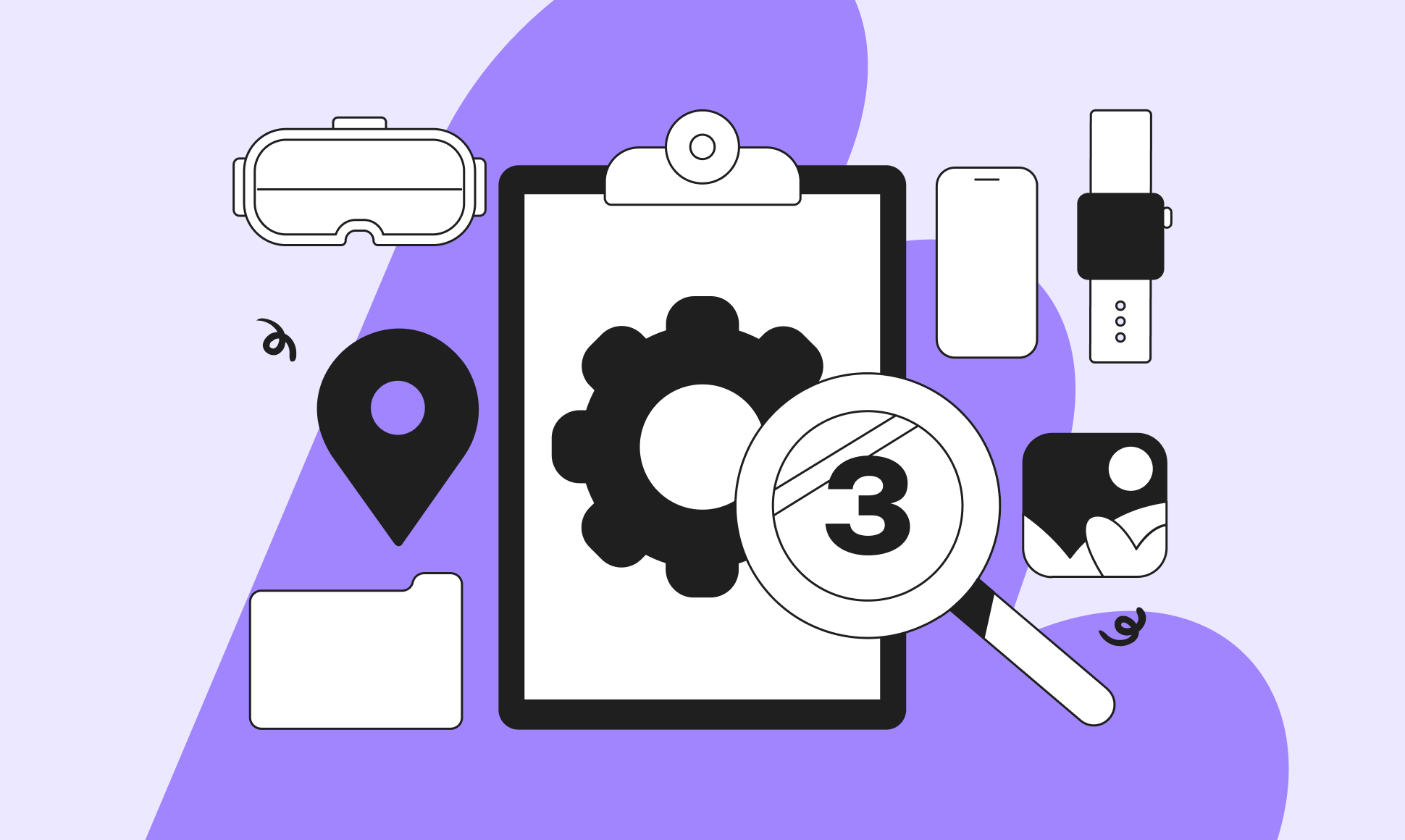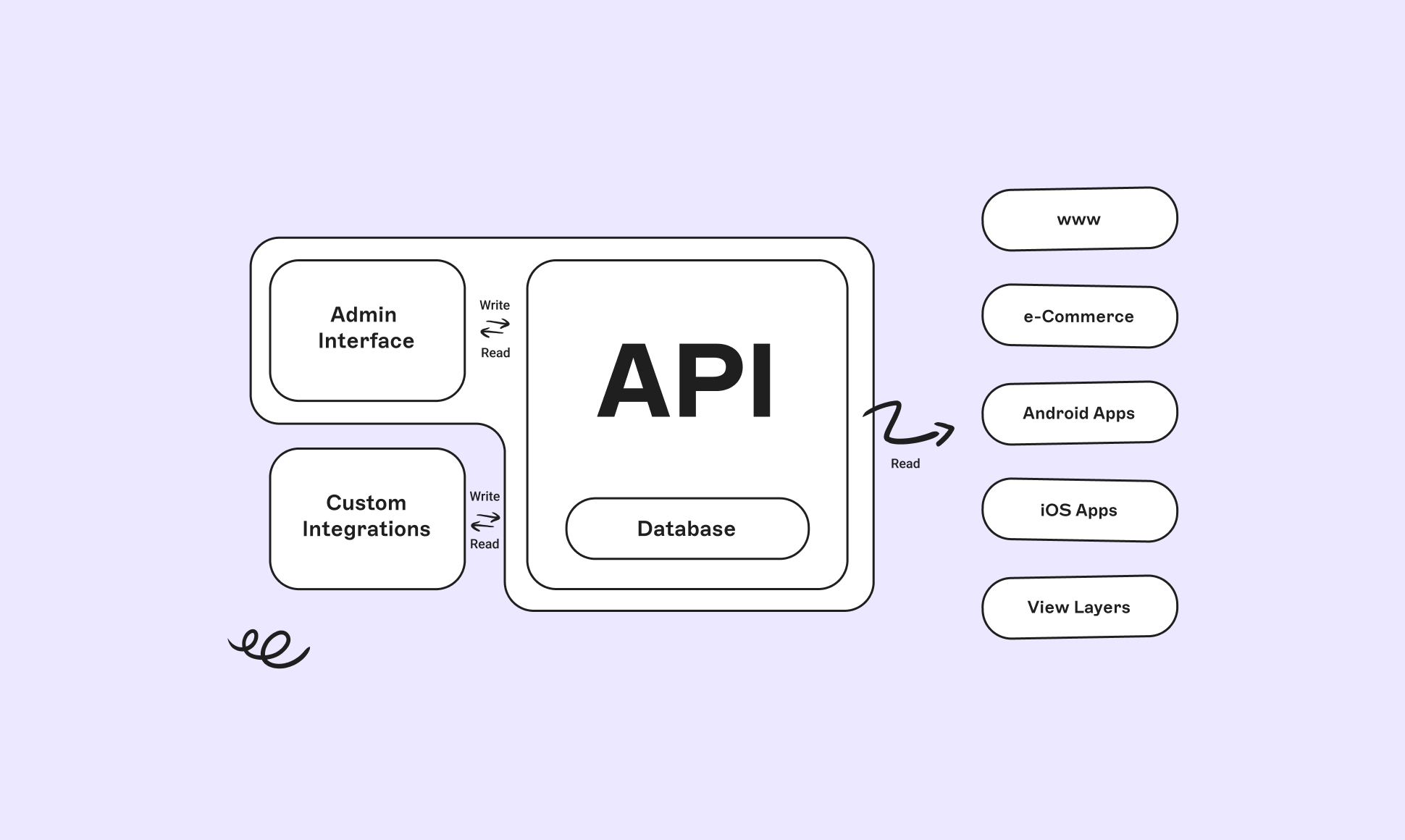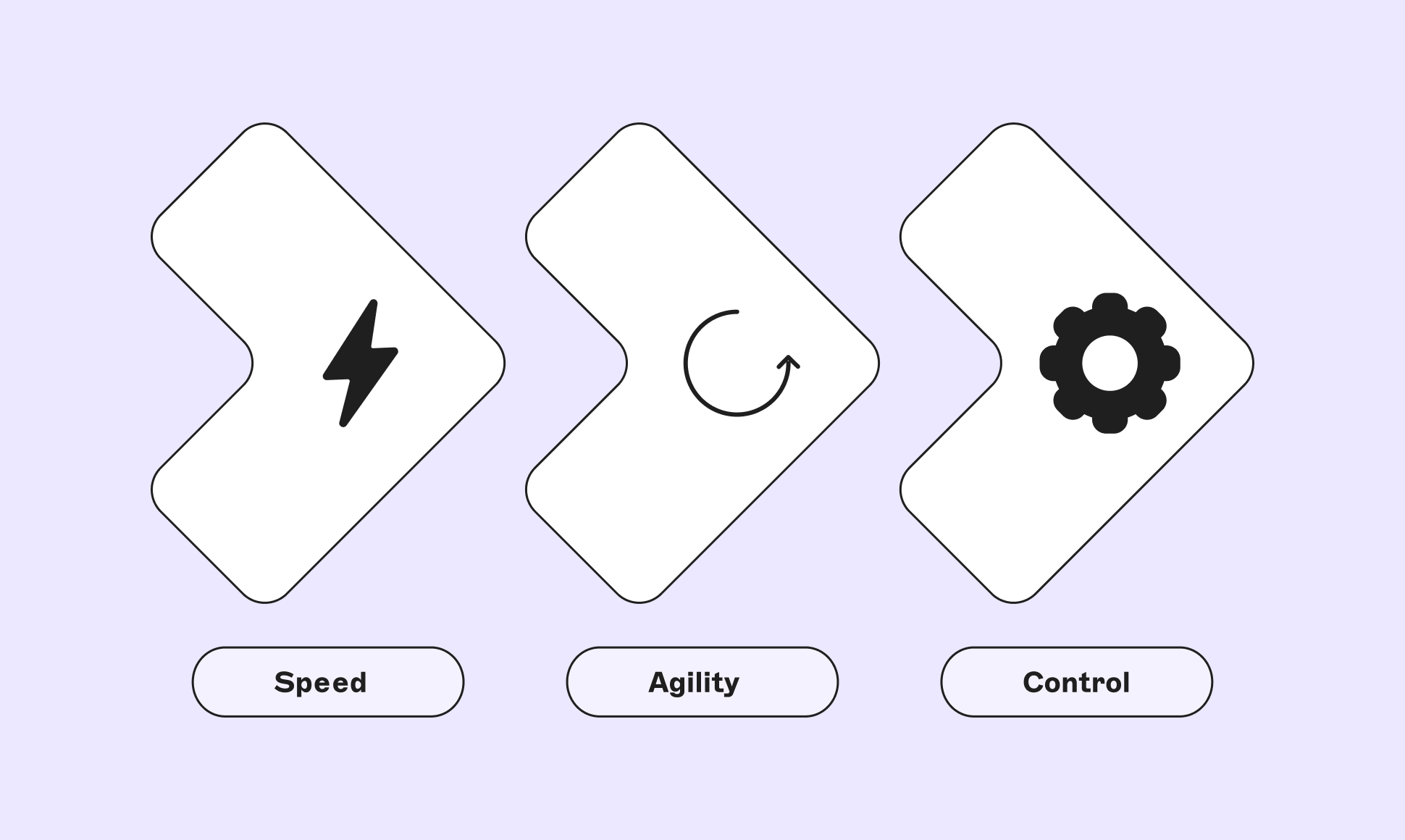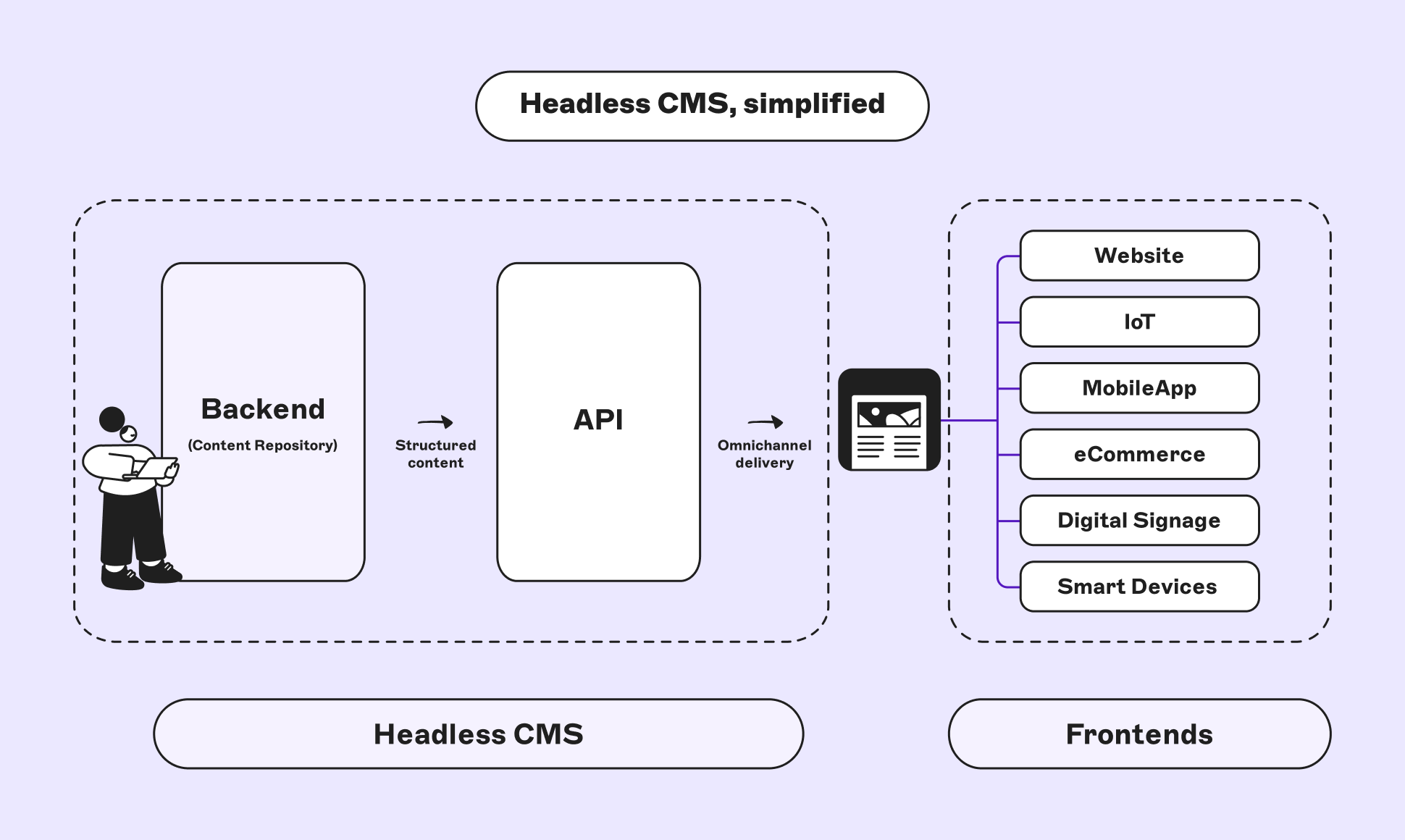How To Choose an Enterprise CMS (3 Steps)
Storyblok is the first headless CMS that works for developers & marketers alike.

- Learn more about headless CMS for enterprise
- Get a free demo of Storyblok (opens in a new window)
- Try Storyblok for free today (opens in a new window)
Like every towering skyscraper relies on a solid foundation, an enterprise Content Management System (CMS) lies at the heart of a successful digital empire. Unfortunately, it’s not as easy as picking any system with “enterprise” in the ad copy. End up with a bad fit, and you could become one of the 41% of people who suffer from unsuccessful migrations (opens in a new window).
But don’t worry, it’s not a coin toss. All the information you need to make an informed choice is out there. By committing to a thorough exploration of your enterprise CMS options, you can find the one that best suits your needs and goals – one that means you never have to migrate again.
In this article, we’ll go over everything you need to know about your enterprise-level CMS search. We’ll cover key features to keep an eye out for, give you step-by-step instructions to find your perfect fit, and list the top 5 best enterprise CMS options to kick-start your search.
Let’s get started!
What is an enterprise CMS?
Let’s start with a definition. A CMS is a piece of software that allows you to create, organize, and publish content. An enterprise CMS is a system that takes that functionality and seamlessly ramps it up to work on a massive scale.
On top of handling huge volumes of content and visitors, they also tend to offer advanced features that big organizations need to thrive. These tend to include, but are not limited to:
- More comprehensive security protections (opens in a new window)
- Customizable workflows and user roles
- Language, localization, and personalization features
Smaller businesses don’t typically need this kind of functionality. But for larger groups and those with an eye on growth, support for scaling and capacity for next-gen digital experiences is a must.

Why is picking the right enterprise-level CMS so important?
Life would be a lot easier if all questions came with a single easy answer – but it would also be a lot more underwhelming, too. Picking an enterprise CMS is the same: there’s no one-size-fits-all solution, and any CMS that claims to offer one isn’t going to live up to the hype.
Finding the right enterprise CMS is about identifying the option best poised to meet your goals, not anyone else’s. A CMS can be the most popular option on the market, but if it doesn’t align with your specific needs, it’s just going to sabotage you in the end.
Plus, a CMS is a big choice with far-reaching consequences for your entire team. You don’t want to waste effort on a migration that won’t stick. Getting the right fit on the first try is going to save you a lot of time, money, and tears. Dedicating resources to finding your ideal system can feel tedious now, but trust us – your future self will thank you.
Key features of an enterprise CMS platform
While it might sound counterintuitive, starting with your core needs isn’t always the best route to finding an enterprise CMS. The fact is, there are a lot of content management systems out there (opens in a new window). It would take years to research every single one and compare them against your goals.
So instead of taking on a task that would make Sisyphus himself wince, start by narrowing down the candidates.
The first step is to only consider true enterprise CMSs. These are systems that, regardless of individual weaknesses and strengths, embody three traits critical for enterprise success: speed, agility, and control.

Speed
Whether it’s locking in a shorter time-to-market or fast-loading pages that meet skyrocketing user expectations (opens in a new window), speed matters for enterprises. You need a CMS that can deliver:
- High-performance pages with minimal downtime and loading
- Seamless workflows and real-time visual previews for fast collaboration
- Publish pipelines that let you publish in hours, not weeks
Agility
In our high-tech, on-demand era, it’s not enough to simply meet user needs. You need to anticipate them, changing plans and offerings on a moment's notice to keep up with the latest trends. And the value of being the first of your competitors to do that can’t be underestimated.
A true enterprise CMS is one that supports your flexibility with tech that works with you instead of against you, including:
- A modular content approach to provide infinite possibilities without having to start from scratch
- Intuitive cross-team collaboration features so devs and marketers can work together without blocking each other
- API-first infrastructure (opens in a new window) so you can add, remove, and change your toolkit on the fly
Control
As convenient as it sounds, one-size-fits-all almost always translates into one-size-fits-none. Every company is different, meaning no monolith can apply to everyone.
But it goes deeper than that. Even specialized solutions – CMSs for ecommerce, for example – will fail to meet your individual needs if you can’t control how they work for you. This can look like:
- Content modeling (opens in a new window) support for structured, scalable, and consistent production
- Long-term versioning, custom workflows, and granular user roles
- Omnichannel publishing capabilities so content can reach your ideal audience no matter where they go
Even with these rules of thumb, figuring out which CMSs really embody them would still take you a good few months to comb through. Fortunately, there’s a more convenient way to ID which systems should make the cut: headless CMS.
Start here: Enterprise headless CMS
A headless CMS is a modern content management system that decouples the backend (where content is stored) from the frontend (where content is presented). Unlike traditional legacy systems, where the two are inseparable, headless CMS allows for game-changing flexibility.

Want to learn more about the ins and outs of headless? Check out our dedicated article, Headless CMS Explained.
Now, keep in mind that your mileage may vary. Not every headless CMS will immediately give you all of the benefits an enterprise needs to succeed. But it’s a strong place to start, and you have a much better chance of finding a good enterprise fit from within this category.
Once you have a few headless options, you can narrow it down with other shortcuts based on your values. For example, if you’re heavily invested in enterprise security (opens in a new window), an ISO 27001 certification signals that a company has gone through the ringer and had its practices independently approved.
Learn more about cybersecurity best practices from Sebastian Gierlinger, VP of Engineering.
Narrowing the field down to headless options makes your search a lot more manageable without sacrificing the core features that support an enterprise CMS. Now that we’ve singled out a few top candidates, it’s time to get into the nitty-gritty of your individual company’s specific needs.
How to choose the best enterprise CMS in 3 steps
Picking an enterprise CMS is one of those things that’s simple, but not easy. It’s a lot of reflection, data gathering, and hands-on experience. But the good news is that applying a structure can streamline the whole process.
Let’s take a look.
Step 1: Define and prioritize your needs
If you’re on the hunt for an enterprise CMS, this step might seem redundant. You probably have your needs on the tip of your tongue: omnichannel delivery, scalable infrastructure, better performance, easier collaboration…
But it’s important to dig a little deeper, too. What do your devs need? How about your marketers? Your customers? What tools and features will you need to achieve your future goals as well as your current ones? It’s worth a few brainstorming sessions with all your stakeholders to ensure nobody will be left out and all plans are accounted for.
Naturally, even the most pragmatic of companies is going to end up with a long wish list. It helps to break them down into three categories: Must-have, nice-to-have, and optional. This will give you a full scope of what your team is asking for while maintaining realistic priorities.
The result of all that legwork will be a detailed profile of your ideal CMS. And just like that, you’re already over the first hurdle: you’ve set yourself up to find a CMS that fits your needs, not one that you’ll just have to make do with.
Step 2: Shop your options and get your hands dirty
Now that you have that personalized checklist, it’s time to put it to work. In addition to some good old-fashioned Googling (or the more modern route, asking ChatGPT), check out the resources that the CMSs themselves provide. Most offer a wealth of information, including:
- Case studies (opens in a new window) that show you how the proposed benefits work in real-world situations. Bonus points if they have enterprise-level clients who solved the same issues you’re dealing with.
- Companies that the CMS partners with (opens in a new window) for a sneak preview of the kind of professional support you can access
- Topics covered by whitepapers (opens in a new window), blog articles (opens in a new window), and webinars (opens in a new window) to show where the CMS’s expertise lies
Webinars are convenient, but even in the digital age, you just can’t beat a real-life touch. Save your spot at JoyConf and learn why enterprises across the world choose Storyblok.
External platforms can also add an unbiased voice to finding an enterprise CMS that fits your needs. Two of the best include:
- G2’s enterprise CMS listings (opens in a new window), which also come with a useful comparison tool
- Gartner’s peer reviews (opens in a new window), which give the full picture by providing both a positive and critical review of each option
And finally, no matter how good an enterprise CMS looks on paper, never commit without getting hands-on experience. Think about it: would you buy a luxury vehicle without giving it a test drive? Unless you have money to burn, the answer is probably “not in a million years”.
The same goes for choosing an enterprise CMS. Reading reports, reviews, and case studies is essential, but it doesn’t give you the full picture. Make sure to take advantage of things like customized demos (opens in a new window) and free trials (opens in a new window), too.
When it comes to data powering this decision, personalized is best. Try out our ROI calculators for a custom quote and see how Storyblok’s 582% return on investment can revolutionize your operations.
Step 3: Work with your provider for a smooth rollout
In the State of CMS 2025 (opens in a new window), CMS users rated a poor onboarding experience as their top migration challenge. Don’t let yourself face the same headaches. Talk to your provider about what to expect and see if there are any roadblocks you can get around early.
Some systems will naturally come with a steeper learning curve than others. Knowing what to expect and having a customer success manager on deck to help can be the difference between a seamless rollout and a CMS nightmare.
It’s also wise to keep that needs list from earlier in mind. Are the benefits you were promised translating into reality? Are the features performing as expected? Is it truly performing the way you need it to? If the answer to any of those questions is “no”, now is the time to address it.
Finally, invest some time in training your team on the new enterprise CMS. A tool is only as powerful as its wielder is skilled: to get the most out of your investment, make sure everyone knows how to leverage it to its full potential.
Top 5 enterprise CMS platforms for 2025
You’re now equipped with a roadmap to evaluating the best enterprise CMS for your team. But if you’re still not sure where to begin, don’t worry – it’s more common than you think, and we’re here to help. Check out 5 of the best enterprise CMS platforms for 2025.
1. Storyblok

With all the roles a modern CMS needs to play – content engine, conversion machine, brand ambassador – it can be hard to find one that will truly tick all the boxes. Storyblok is the rare enterprise CMS that will knock out your to-do list and then some.
Powerful enough to handle global content operations while remaining intuitive for teams of all tech levels, Storyblok makes content management a breeze with features like:
- AI-ready design supporting structured content from the get-go, so generative engines find and cite your brand first
- Easy-to-use Visual Editor for endlessly (and easily!) customizable content at scale
- Modern composable architecture for a forever future-proof tech stack
- Customizable user roles, workflows, and access permissions

In addition to being beloved by devs and marketers alike, it’s got everything a modern enterprise needs. With control to build your ideal, personalized tool kit and scalability that accelerates your reach with a snap of your fingers, you’re not just avoiding bottlenecks: you’re smashing them to pieces. Skip the bloated excess and embrace a sleek, future-ready, success-primed enterprise CMS with Storyblok.

Contentful has gained a reputation as one of the biggest enterprise CMS names on the market. With flexible headless architecture and omnichannel features, it allows users to create modern content experiences at scale. However, it’s worth noting that this comes with a caveat: it often requires extensive dev work for even basic changes. This is not always the fastest, most efficient way to deliver a market impact, especially when scaling. The hidden complexity (and if you’re not lucky, hidden cost) can slow down companies looking for a faster, more user-friendly solution.
3. WordPress (opens in a new window)

WordPress is arguably the most well-known of the legacy CMSs. It’s a classic for a reason: getting started is easy, and since you’ve probably used a WordPress site at some point in your life, the interface can feel familiar. If you’re an enterprise that doesn’t need to provide advanced content experiences, WordPress’s relatively simple architecture probably won’t pose a problem. But if you’re looking for major expansion and cutting-edge digital experiences, now or anytime in the future, opting for WordPress now is likely to lead to yet another migration in a few years.
4. Adobe Experience Manager (AEM) (opens in a new window)

Adobe Experience Manager (AEM) is the content management engine for the wider Adobe ecosystem. If you use any of their other products, you’ll probably feel right at home. This can be both a blessing and a curse. You gain some convenience, but lose technical flexibility and a few degrees of agility. And while AEM can offer companies a lot of firepower, it’s crucial to make sure you know how to use it: AEM is famously complex, meaning non-technical users tend to struggle with usability and devs face higher operational costs.
5. Contentstack (opens in a new window)

With an extensive app ecosystem, Contentstack often pops up on lists of customizable enterprise CMSs. The headless architecture is also a plus, leaving most legacy pitfalls behind. Nevertheless, some enterprise users feel it doesn’t quite fit the bill: some wish there were more built-in marketing, and many struggle with the infamously steep learning curve.
Key takeaways
A major purchase without research isn’t an investment. It’s a gamble. And when it comes to crafting a digital content strategy, it’s a gamble you can’t afford. Fortunately, you don’t have to go in blind. By thoroughly considering your needs and options, you can make sure your next migration is the last you’ll ever do.
Enterprise CMS FAQs
How much does enterprise CMS cost?
On the enterprise level, cost tends to vary based on your needs and goals. More functionality and content will typically add up to more charges. However, the type of CMS you choose will also impact your final bill. One study found that companies using headless systems spent an average of nearly $88,500 less than businesses with legacy systems on the total cost of CMS ownership. Get the full story for free in Headless CMS Pricing Vs. Legacy: Which Gives Enterprises More Value? (opens in a new window)
Who should be involved in picking an enterprise-level CMS?
Any team that will be working with the CMS should be involved in the decision. After all, you don’t want a system that your devs hate or your marketers can’t work with. A good starting point is to ask each of your teams what their content management concerns are before you begin your search. That way, you can roll it into your overall criteria and make sure you pick a CMS that’s truly for all teams.
Do you need an enterprise CMS?
If you’re an enterprise-grade organization – or a smaller one with big plans – an enterprise CMS is a must. It’s the tech at the center of your content strategy and can be the difference between obscurity and massive brand awareness. However, if your business plans will have you thriving on the smaller side, or you’re sticking to a basic one-in-one-out content strategy, it might not be the best investment for you.
What is the best enterprise CMS?
If you want a bigger, faster market impact, Storyblok is the enterprise CMS for developers (opens in a new window) and marketers (opens in a new window) alike. It’s easy to use, powerful, and the key to fast expansion with cutting-edge digital content experiences. Check out the link below to get in touch, or sign up for a free trial today.



